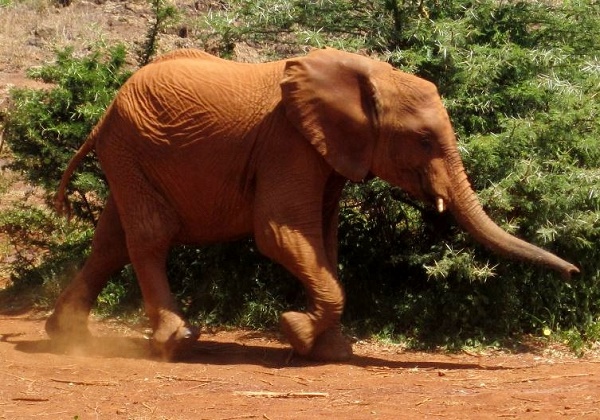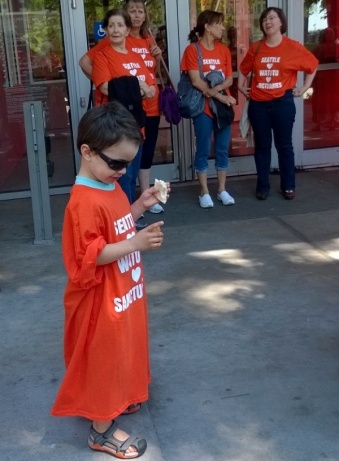I recently met up with Scott Nelson, the founder of ESPFund, an organization that is helping African elephants. I wanted to learn more about how ESPFund came to be. Here’s what I learned:
What is ESPFund?
ESPFund is short for Endangered Species Protection Fund, a Seattle-based 501c3 nonprofit helping to stop the extinction of African elephants, and by extension also helping rhinos, lions, giraffes, and other wildlife. We partner with African communities to help them protect the biodiversity not only of their areas, but of the earth overall, since many species and ecosystems exist only in Africa.
How did ESPFund get started?
I see the over-exploitation of our environment as the biggest issue of our time, and I was not comfortable ignoring my love of elephants and letting others fight for them. I am not able to ignore the killing of such an amazing creature as the elephant. It goes against everything that I am and that I believe about myself and my place in the universe. We can all learn from elephants. Most people would agree that they are amazing, and yet we kill them by the thousands, and historically, by the millions. We are now down to the last remaining few.

What drew you to elephants?
This species is considered keystone, and their prevalence is indicative of a healthy ecosystem. They are so unique, so majestic and representative of the wild blue yonder, and so intelligent, that to me their decimation represents one of the clearest cases of humans destroying our very own habitat. I believe that elephants are like the canary in the mineshaft, and that the fate of humans is linked to the fate of elephants. If we lose them, it means we have irrevocably lost our way and poisoned our own environment beyond the point of no return. If we cannot protect such an intelligent being as the elephant, can we save ourselves from our own destructive ways?
How are you different from other organizations that help endangered animals?
We believe people need better options for channeling their conservation interests into change. Traditionally, many nonprofits start off with a noble idea, but in the growth process, they become large companies where accountability can become hazy, salaries get excessive, and the activities become too self-serving and competition-based. We are volunteers who are motivated by the mission, and our focus is specific, specialized, micro: Stop the poaching of elephants by giving Seattle and others a direct link to conservation in Africa.
In Africa, this must be intertwined with community involvement, so that is why we partner with other nonprofits whose missions center economic development. In this way we appeal to those supporters whose hot button is the poaching of endangered species, and we give those supporters a direct link to the front line. The collaboration aspect also provides a greater degree of oversight and accountability, because nobody wants to partner with a shady organization.
Can you explain a bit about the goals of ESPFund and how you’re meeting these goals?
We want to help communities secure areas where wildlife will be safe in the long run. We start by finding community groups that are trustworthy and motivated. Right now we are focused in Kenya, near Tsavo West National Park and Mt. Kilimanjaro. We have partnered with a community group that falls between the areas tended to by larger nonprofits. We are getting their community rangers trained and equipped so they can work alongside the Kenya Wildlife Service and other private rangers, sharing resources and expanding their reach.
Our goal is to turn this patchwork of private and government rangers into a cohesive, effective network, and get them to a point where their operating area is free of poaching. Along the way we assist the community in forming a wildlife preserve within the protected area so they can bring in tourists and make a living by showing off their amazing part of the world. We then take the same model and apply it to a new area, and so on.

What are the highlights of your work with ESPFund so far?
Working with the community rangers is amazing. We trained them on self-defense and first aid, along with training on Kenya’s wildlife laws and integrating with Kenya Wildlife Service (KWS). Many of them are former poachers who are now passionate about saving wildlife. One of the rangers is a member of the Maasai tribe who rides his bicycle for three hours on rough dirt roads to get to get to the patrol area. That’s dedication!
We also recently promoted the Global March for Elephants and Rhinos in Seattle where we had Tom Skerritt speak, along with Sam Wasser from the UW and Wendie Wendt from Big Life. It was part of a worldwide awareness-raising campaign, and we made many contacts around the world that we will work with in the near future. Also, working with the leaders of other nonprofits, planning and strategizing, is promising and encouraging for the future of wildlife in East Africa.
What’s next for you and the Fund?
The elephants are coming! They will be making a stand in Seattle. Look for the Elephants’ Last Stand in the coming months around the city. This will be a large fundraiser. As soon as funds are available, we will be focusing on building a ranger base in Kenya, getting rangers trained by KWS and better equipped, and expanding our efforts into Tanzania.
How can people help your cause?
We need help in all forms! We need contacts and introductions to people and organizations that want to save wildlife. Donations of funds and outdoor equipment are sorely needed. (editor’s note: Look for the Donate Now button on the ESPFund home page)
We make every dollar count and not a cent is spent on overhead costs. Every member of our organization is donating their time and energy, and I personally oversee the allocation of all assets. We need someone with WordPress expertise to help with our website, and we need motivated and reliable people to join our fundraising committee. A graphic designer is needed for flyer production and other graphics. Soon we will need adventurous volunteers to come to Kenya and help build a ranger base. Lastly, I direct you to our What You Can Do page.
It is imperative that everyone who cares about wildlife starts to think much more frequently about doing what they can to save the animals we have left. And if you care about African wildlife and want to help save it, we want to hear from you.
Anything else you would like to add?
Well, yes, if I may step onto my soapbox for a bit, I would like to close with this:
For thousands of years elephants have been persecuted, while simultaneously revered for their intelligence, compassion, and “godliness.” King Solomon, Roman emperors, and countless ancient kings and leaders in Europe, while hunting the elephants for their ivory and using them for war, along with philosophers like Aristotle, Pliney, and Aelian, all praised the elephants for their power, intelligence, community spirit, and moral virtues. Edward Topsell, a naturalist and parson in the 1600’s, summed elephants up by saying “there is no creature among all the beasts of the world which hath so great and ample demonstration of the power and wisdom of almighty god as the elephant.”
There are many authors, scientists, conservationists, and even the occasional politician, all saying that the wild is vanished, that the end of nature is here. Personally, I agree with them. I have seen it in what most people consider the wildest place on earth: Africa. The African wild is gone, taken over by overpopulation and corporate and political interests. We as humans have successfully tamed, bent, and broken nonhuman life to our desires, and we have proven our dominance over our surroundings, to our own detriment. And we are continuing to do so by continuing to believe and act as if we are separate from other life forms, and smarter than other life forms. In the coming years we will see iconic species after species disappear forever from earth because we failed to respect their instinctual desire for contentment and survival, and we failed to understand that our own survival is intertwined with theirs.
There seems to be a collective view that as long as there is a dam providing us power, a farm providing us food, a factory providing us gadgets and technology, and our 401k is growing, then we have what we need and everyone and everything else is either extra or irrelevant. We forgot that we need nature. Nature does not need us, but we need nature for our own survival. It is easy to forget we need nature, because the day-to-day changes in our surroundings are so minute that we barely notice the slow deterioration of our environment. But when we step back and look at the changes of our planet on a decade by decade basis, then we see how much things have “progressed.”
I believe we as humans on this earth are at a critical point, a point where if we are not actively working to create positive change, then we are actively hurting ourselves and our future as a species. It is time for each of us to change course and show our dominance in new ways. By showing respect for all other creatures and their habitats, we can show that the new dominance is a spirit of protectiveness, humility, and cooperation. It is the only way that we can protect our own future as a species.

Thank you Scott! I’m happy to be involved is such a noble and urgent cause.




















